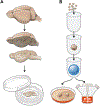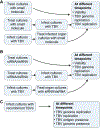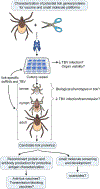The Use of Ex Vivo Organ Cultures in Tick-Borne Virus Research
- PMID: 29473735
- PMCID: PMC6350930
- DOI: 10.1021/acsinfecdis.7b00274
The Use of Ex Vivo Organ Cultures in Tick-Borne Virus Research
Abstract
Each year there are more than 15 000 cases of human disease caused by infections with tick-borne viruses (TBVs). These illnesses occur worldwide and can range from very mild illness to severe encephalitis and hemorrhagic fever. Although TBVs are currently identified as neglected vector-borne pathogens and receive less attention than mosquito-borne viruses, TBVs are expanding into new regions, and infection rates are increasing. Furthermore, effective vaccines, diagnostic tools, and other countermeasures are limited. The application of contemporary technologies to TBV infections presents an excellent opportunity to develop improved, effective countermeasures. Experimental tick and mammal models of infection can be used to characterize determinants of infection, transmission, and virulence and to test candidate countermeasures. The use of ex vivo tick cultures in TBV research provides a unique way to look at infection in specific tick organs. Mammal ex vivo organ slice and, more recently, organoid cultures are additional models that can be used to elucidate direct tissue-specific responses to infection. These ex vivo model systems are convenient for testing methods involving transcript knockdown and small molecules under tightly controlled conditions. They can also be combined with in vitro and in vivo studies to tease out possible host factors and potential vaccine or therapeutic candidates. In this brief perspective, we describe how ex vivo cultures can be combined with modern technologies to advance research on TBV infections.
Keywords: flavivirus; organ; therapeutic; tick; vaccine; virus.
Conflict of interest statement
Conflict of Interest
The authors declare no financial competing interests or conflict of interests.
Figures




Similar articles
-
Dissecting Flavivirus Biology in Salivary Gland Cultures from Fed and Unfed Ixodes scapularis (Black-Legged Tick).mBio. 2019 Jan 29;10(1):e02628-18. doi: 10.1128/mBio.02628-18. mBio. 2019. PMID: 30696737 Free PMC article.
-
Flavivirus Infection of Ixodes scapularis (Black-Legged Tick) Ex Vivo Organotypic Cultures and Applications for Disease Control.mBio. 2017 Aug 22;8(4):e01255-17. doi: 10.1128/mBio.01255-17. mBio. 2017. PMID: 28830948 Free PMC article.
-
Ixodid Tick Dissection and Tick Ex Vivo Organ Cultures for Tick-Borne Virus Research.Curr Protoc Microbiol. 2020 Dec;59(1):e118. doi: 10.1002/cpmc.118. Curr Protoc Microbiol. 2020. PMID: 33030816 Free PMC article.
-
Exploring approaches and advancements in the development and evaluation of multi-epitope subunit vaccines against tick-borne viruses.Vet Microbiol. 2025 Jul;306:110577. doi: 10.1016/j.vetmic.2025.110577. Epub 2025 Jun 2. Vet Microbiol. 2025. PMID: 40466409 Review.
-
Potential Mechanisms of Transmission of Tick-Borne Viruses at the Virus-Tick Interface.Front Microbiol. 2022 May 5;13:846884. doi: 10.3389/fmicb.2022.846884. eCollection 2022. Front Microbiol. 2022. PMID: 35602013 Free PMC article. Review.
Cited by
-
Dissecting Flavivirus Biology in Salivary Gland Cultures from Fed and Unfed Ixodes scapularis (Black-Legged Tick).mBio. 2019 Jan 29;10(1):e02628-18. doi: 10.1128/mBio.02628-18. mBio. 2019. PMID: 30696737 Free PMC article.
-
Live Imaging.Curr Issues Mol Biol. 2021;42:385-408. doi: 10.21775/cimb.042.385. Epub 2020 Dec 12. Curr Issues Mol Biol. 2021. PMID: 33310914 Free PMC article. Review.
-
Towards modelling tick-virus interactions using the weakly pathogenic Sindbis virus: Evidence that ticks are competent vectors.Front Cell Infect Microbiol. 2024 Mar 19;14:1334351. doi: 10.3389/fcimb.2024.1334351. eCollection 2024. Front Cell Infect Microbiol. 2024. PMID: 38567020 Free PMC article.
-
How relevant are in vitro culture models for study of tick-pathogen interactions?Pathog Glob Health. 2021 Oct-Dec;115(7-8):437-455. doi: 10.1080/20477724.2021.1944539. Epub 2021 Jun 30. Pathog Glob Health. 2021. PMID: 34190676 Free PMC article. Review.
-
The Unfolded-Protein Response Triggers the Arthropod Immune Deficiency Pathway.mBio. 2022 Aug 30;13(4):e0070322. doi: 10.1128/mbio.00703-22. Epub 2022 Jul 18. mBio. 2022. PMID: 35862781 Free PMC article.
References
-
- Labuda M; Nuttall PA, Tick-borne viruses. Parasitology 2004, 129 Suppl, S221–245. - PubMed
Publication types
MeSH terms
Grants and funding
LinkOut - more resources
Full Text Sources
Other Literature Sources

